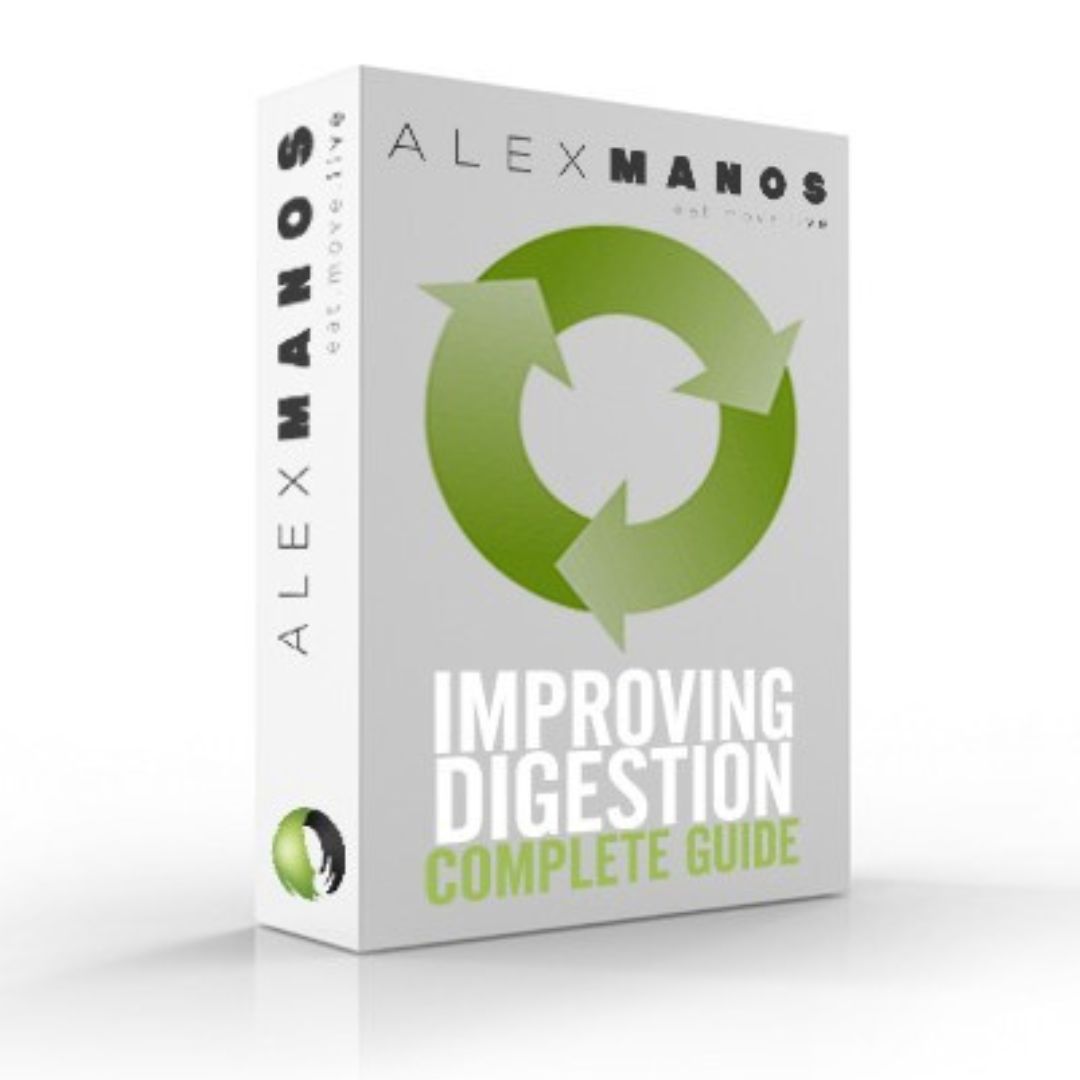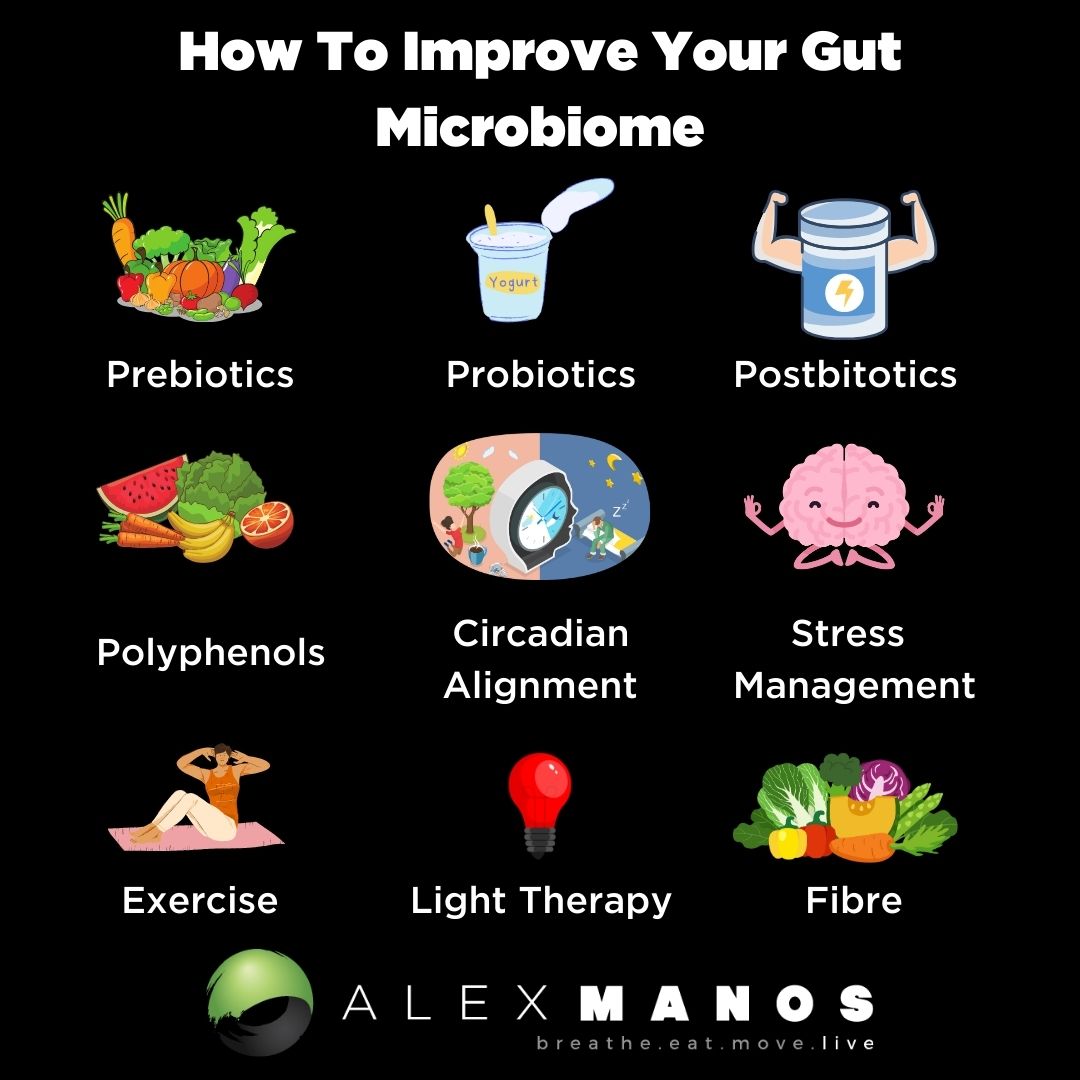Welcome to my blog ‘How to improve your gut microbiome?’
What Is The Gut Microbiome?
The gut microbiome is a term often used to describe the bacteria that reside within our digestive tracts. However this isn’t strictly accurate.
More accurately this refers to our gut microbiota.
Our gut microbiome is the set of bacterial genomes coexisting with ours – i.e it’s the bacteria and their genes, or genome. What’s fascinating is that its coding capacity is 150-fold higher than that of the human genome! What this means is that the gut microbiome provides functional features that humans have not evolved, for example the break down of dietary fibres.
How Does The Gut Microbiome Effect Health?
The gut microbiome not only supports healthy gut function, but it also supports systemic health.
The gut microbiome has been associated with a range of diseases ranging from more obvious ones such as Irritable Bowel Syndrome and Inflammatory Bowel Disease to perhaps less obvious ones such as eczema and psoriasis, to autoimmune conditions such as rheumatoid arthritis and even neurodegenerative conditions such as Alzheimer’s and Parkinson’s disease.
We now understand that there are various gut-axis in the body, such as the gut-brain axis and the gut-skin axis as well as the gut-lung axis.
The gut supports the health of these distant organs via different mechanisms, but a common one is via modulating our immune system and thus inflammatory state. Our gut bacteria produce various metabolites that communicate with our own cells, modulating our immune systems and maintaining order. When an imbalance in the microbiome occurs, called dysbiosis, this communication will also be effected impacting our immune system and thus our systemic health.
Gut Microbiome Test
If you are based in the U.K you can complete a comprehensive gut microbiome test from Healthpath.
How To Improve Your Gut Microbiome
Diet
The first thing to know is that our diet is a primary way you can improve your gut microbiome. Research has shown that a diet with adequate intake of dietary fibre and micronutrients will support a diverse microbiome. There is a correlation between the diversity of our diet (i.e the number of different foods we eat) and the diversity of our gut microbiome. This is important because a diverse microbiome is a more resilient microbiome – meaning that it is less effected via stressors such as antibiotics.
Prebiotics
It’s important that when ever we can we take a food first approach. Dietary sources of prebiotics include things like leeks, onion, garlic, asparagus, wheat, and lentils. While we want to focus on getting prebiotics via our diet, there are times when we may want to consider supplementing prebiotics. Specific prebiotics generally feed specific bacteria and thus we have two approaches that can be considered when looking to improve our gut microbiome with prebiotics:
- Rotate between different prebiotics or supplement a broad spectrum prebiotic.
- Complete a gut microbiome test to understand what prebiotics might be most helpful/effective.
The most common options include PHGG, FOS, GOS, XOS, and inulin.
Probiotics
Taking a food first approach, we can consume probiotics in our diet via eating live yoghurt and fermented produce such as kefir, sauerkraut or kimchi.
But there are times when we might need to consider supplementing a probiotic. These can be tailored to the individual based on symptoms as we now know that specific probiotics provide specific benefits. Some strains of bacteria are effective in improving diarrhoea or constipation, while others are effective in reducing anxiety or depression (these are known as psychobiotics).
A recent study showed that the administration of Saccharomyces boulardii for four weeks resulted in a significant reduction in the daily number of evacuations and diarrhea in patients with IBS (source).
Read my blog on probiotics to learn more about which probiotic might be most appropriate.
Postbiotics
The International Scientific Association for Probiotics and Prebiotics (ISAPP) defined a postbiotic as “a preparation of inanimate microorganisms and/or their components that confers a health benefit on the host”. (source) The most researched, and one we can supplement is butyrate. Butyrate has anti-inflammatory, immune-modulating properties and is important for maintaining a healthy gut wall (i.e preventing leaky gut). It’s important to note that the above three recommendations have the capacity to increase butyrate so we may not need to supplement this short chain fatty acid. Read my blog What Causes Dysbisois to learn more about the importance of butyrate in maintaining a healthy microbiome.
There are times when supplementing butyrate can be helpful and there is a form which I have found to be far more effective than the more traditional sodium butyrate.
Recommended product: Tributyrin.
Dietary Fibers
As mentioned at the beginning of the blog, dietary fiber, which refers to the carbohydrates found in plants (such as fruits, vegetables, legumes, nuts, seeds and grains) cannot be metabolised by human digestive enzymes. Instead, dietary fiber can be metabolised by the gut microbiome.
In the research a high-fiber diet has been consistently been shown to increase microbiome diversity and short-chain fatty acid producing bacteria in the human gut. Short-chain fatty acid are the main players in the interplay between diet, microbiota, and host health.
The recommended daily intake for adults is between of 28−35g.
Polyphenols
Another way to improve your gut microbiome is via the consumption of polyphenols. Polyphenols are what give our food their colour. So a diet which is colourful will be providing plenty of polyphenols. Some foods particular high in polyphenols include coffee, olives and olive oil, green tea, green and red peppers, tomatoes, berries (and the list goes on!).
The advantage of polyphenols over dietary fibre and prebiotics is that they are not fermentable. So those with IBS/SIBO issues will need to really focus on polyphenol intake to make up for the fact that you may need to lower your intake of prebiotic foods and certain fibres to improve your gut microbiome.
Recommended Product: Bio.Me Essential
Exercise
Exercise is an effective way to improve your gut microbiome. It has been shown to support a healthy gut microbiome. Exercise not only increases microbiome diversity (thought to be a key marker of gut health) but it also increases the metabolic output of the gut bacteria – meaning they actually produce more metabolites such as butyrate already mentioned. In a systematic review published in 2023 it was concluded:
“The findings show that participation in exercise of moderate to high-intensity for 30–90 min ≥3 times per week (or between 150–270 min per week) for ≥8 weeks is likely to produce changes in the gut microbiota. Exercise appears to be effective in modifying the gut microbiota in both clinical and healthy populations.”
Circadian Alignment
A foundation for a healthy gut and gut microbiome is a healthy circadian rhythm. This means having a healthy relationship with light – going to bed at a decent time (around 10:00) and limiting your exposure to artificial light at night. I recommend considering investing in a pair of blue light blocking glasses and some blue light blocking light bulbs for your home.
Stress Management
In one study a mindfulness-based stress reduction training program was associated with robust improvements in gut symptoms and associated problems in participants with IBS. Although significant increases in three of the five measured facets of mindfulness were found, regression analyses suggest that increases in the ability to retain present moment focus and act with awareness may be particularly important for improving outcomes in individuals with IBS. Now this study didn’t specifically look at the microbiome, but we know that there are underlying imbalances in the gut microbiome in those with IBS.
And so it isn’t too much of a stretch to assume here that the particiapants had an improvement in their gut microbiome that contributed to the “robust improvements”.
Photobiomodulation
Photobiomodulation refers to using light to improve health. Research has shown that using near infrared and infrared light can improve your gut microbiome. Red light therapy has been shown to improve gut microbiome diversity – amazing isn’t it?!
Red light therapy for the gut microbiome could remediate mitochondrial dysfunction in gut neurons, reinstating the complex bidirectional communication system between the enteric nervous system and the central nervous system (the gut/brain axis). (source)
This may have particular significance for neurodegenerative conditions, such as Alzheimer’s and Parkinson’s diseases, both of which involve early pathological abnormalities in the gut/brain axis.
You can read more in depth about this connection in my blog Red Light Therapy For The Gut Microbiome.
My Interview With Kiran Krishnan
Summary
So you have numerous ways to improve your gut microbiome ranging from diet, to supplements to lifestyle factors such as stress management and red light therapy.
Alex is a certified Functional Medicine Practitioner (IFMCP) and has a MSc in Personalised Nutrition. He is also a breathwork facilitator with a background in personal training and massage therapy. He also runs The Resiliency Program - a 24 week program aimed at building physical, mental, emotional, and spiritual resilience.







